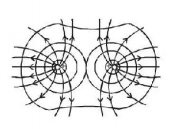1.
As per the diagram, a point charge $$+q$$ is placed at the origin $$O.$$ Work done in taking another point charge $$- Q$$ from the point $$A$$ [coordinates $$\left( {0,a} \right)$$ ] to another point $$B$$ [coordinates $$\left( {a,0} \right)$$ ] along the straight path $$AB$$ is:
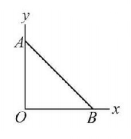
A.
zero
B.
$$\left( {\frac{{ - qQ}}{{4\pi {\varepsilon _0}}}\frac{1}{{{a^2}}}} \right)\sqrt 2 a$$
C.
$$\left( {\frac{{qQ}}{{4\pi {\varepsilon _0}}}\frac{1}{{{a^2}}}} \right).\frac{a}{{\sqrt 2 }}$$
D.
$$\left( {\frac{{qQ}}{{4\pi {\varepsilon _0}}}\frac{1}{{{a^2}}}} \right).\sqrt 2 a$$
Answer :
zero
2. A unit charge moves on an equipotential surface from a point $$A$$ to point $$B,$$ then
A.
$${V_A} - {V_B} = + ve$$
B.
$${V_A} - {V_B} = 0$$
C.
$${V_A} - {V_B} = - ve$$
D.
it is stationary
Answer :
$${V_A} - {V_B} = 0$$
3. Three charges $$- q, +q$$ and $$+q$$ are situated in $$X-Y$$ plane at points $$\left( {0, - a} \right),\left( {0,0} \right)$$ and $$\left( {0,a} \right)$$ respectively. The potential at a point distant $$r\left( {r < a} \right)$$ in a direction making an angle $$\theta $$ from $$Y$$-axis will be
A.
$$\frac{{Kq}}{r}\left( {1 - \frac{{2a\cos \theta }}{r}} \right)$$
B.
$$\frac{{2kq\cos \theta }}{{{r^2}}}$$
C.
$$\frac{{Kq}}{r}$$
D.
$$\frac{{Kq}}{r}\left( {1 + \frac{{2a\cos \theta }}{r}} \right)$$
Answer :
$$\frac{{Kq}}{r}\left( {1 + \frac{{2a\cos \theta }}{r}} \right)$$
4. Which of the following figure shows the correct equipotential surfaces of'a system of two positive charges ?
A.
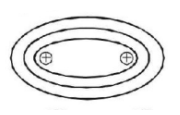

B.
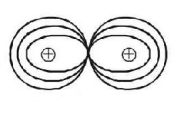

C.
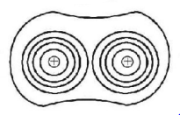

D.
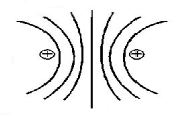

Answer :


5. A charge $$Q$$ is distributed over two concentric hollow spheres of radii $$r$$ and $$R\left( {R > r} \right)$$ such that the surface densities are equal. The potential at the common centre is $$\frac{1}{{4\pi {\varepsilon _0}}}$$ times -
A.
$$Q\left[ {\frac{{r + R}}{{{r^2} + {R^2}}}} \right]$$
B.
$$\frac{Q}{2}\left( {\frac{{r + R}}{{{r^2} + {R^2}}}} \right)$$
C.
$$2Q\left( {\frac{{r + R}}{{{r^2} + {R^2}}}} \right)$$
D.
zero
Answer :
$$Q\left[ {\frac{{r + R}}{{{r^2} + {R^2}}}} \right]$$
6. Two metal pieces having a potential difference of $$800\,V$$ are $$0.02\,m$$ apart horizontally. A particle of mass $$1.96 \times {10^{ - 15}}kg$$ is suspended in equilibrium between the plates. If $$e$$ is the elementary charge, then charge on the particle is
A.
8
B.
6
C.
0.1
D.
3
Answer :
3
7. A conducting sphere of radius $$R$$ is given a charge $$Q.$$ The electric potential and the electric field at the centre of the sphere respectively are:
A.
0 and $$\frac{Q}{{4\pi {\varepsilon _0}{R^2}}}$$
B.
$$\frac{Q}{{4\pi {\varepsilon _0}R}}$$ and 0
C.
$$\frac{Q}{{4\pi {\varepsilon _0}R}}$$ and $$\frac{Q}{{4\pi {\varepsilon _0}{R^2}}}$$
D.
Both are 0
Answer :
$$\frac{Q}{{4\pi {\varepsilon _0}R}}$$ and 0
8.
Two charges $${q_1}$$ and $${q_2}$$ are placed $$30\,cm$$ apart, as shown in the figure. A third charge $${q_3}$$ is moved along the arc of a circle of radius $$40\,cm$$ from $$C$$ to $$D.$$ The change in the potential energy of the system is $$\frac{{{q_3}}}{{4\pi {\varepsilon _0}}}k,$$ where $$k$$ is
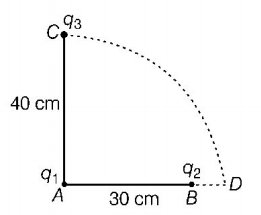
A.
$$8{q_2}$$
B.
$$8{q_1}$$
C.
$$6{q_2}$$
D.
$$6{q_1}$$
Answer :
$$8{q_2}$$
9. From a point charge, there is a fixed point $$A.$$ At $$A,$$ there is an electric field of $$500\,V/m$$ and potential difference of $$3000\,V.$$ Distance between point charge and $$A$$ will be
A.
$$6\,m$$
B.
$$12\,m$$
C.
$$16\,m$$
D.
$$24\,m$$
Answer :
$$6\,m$$
10.
Two charges $${{q_1}}$$ and $${{q_2}}$$ are placed $$30\,cm$$ apart, as shown in the figure. A third charge $${{q_3}}$$ is moved along the arc of a circle of radius $$40\,cm$$ from $$C$$ to $$D.$$ The change in the potential energy of the system is $$\frac{{{q_3}}}{{4\pi { \in _0}}}k,$$ where $$k$$ is
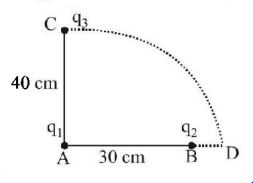
A.
$$8{q_1}$$
B.
$$6{q_1}$$
C.
$$8{q_2}$$
D.
$$6{q_2}$$
Answer :
$$8{q_2}$$
